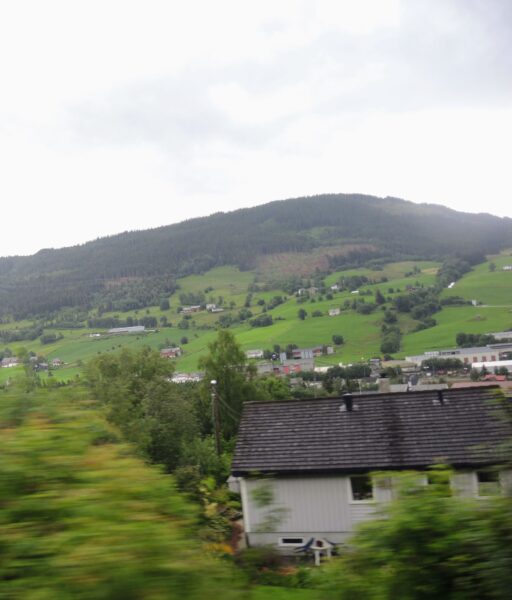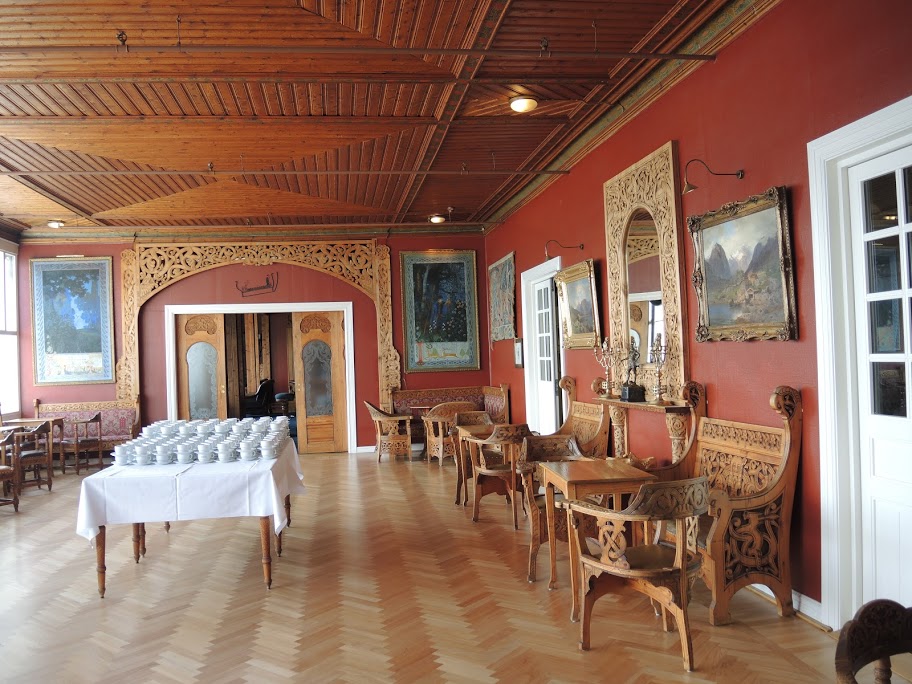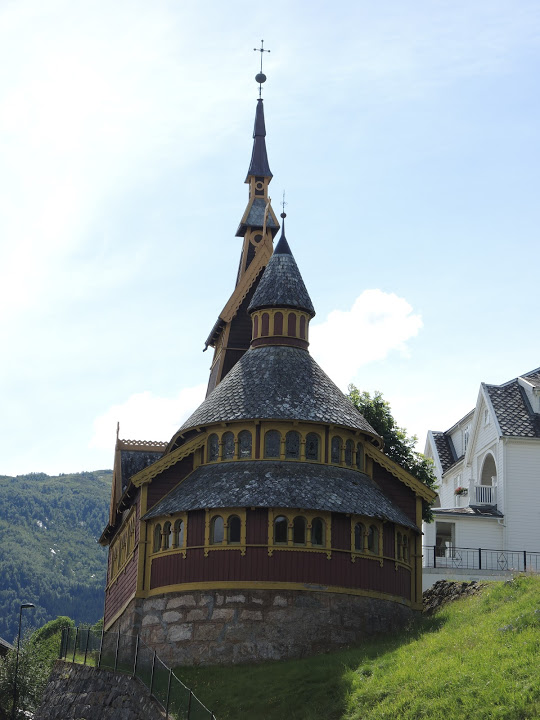We would spend two nights and another full day in Balestrand. I think most of the group is happy to have a relaxed day in the middle of the trip. Frederick led most of the group on a walking tour of the very small town of Balestrand. I opted out, first because I planned to write and to use the stronger internet signal in the lobby but also because it was a day when discretion strongly suggested that I not stray too far from a commode either temporally or spatially.
Slightly more than 1,300 people reside in Balestrand, which sits at the top of the Sognefjord. Although it’s slightly larger, though comparable in size to Ulvik, it’s not, in my opinion, as lovely. The original part of the hotel, however, which was built in the 19th century, has a serene view of the fjord and allows you to experience the scene from rooms that are quite impressive.
I sat in the hotel ingesting the view and trying to digest some of what I’d learned about Norway and Scandinavia. (The unsettled state of my intestinal tract was clearly on my mind when I wrote this sentence.) Let me share some of that with you.
While each of the three Scandinavian countries remains a monarchy, the monarchies themselves and the relationship of the population to their monarchs is markedly different from that frequently seen in European countries farther south – perhaps because their populations historically have been and continue to be rather sparse.
With about 9,600,000 people, Sweden has nearly twice the population of either of the other two Scandinavian countries. Denmark has 5,600,000 people and Norway is the most sparsely populated at 5,100,000. However, with a density of 129 people per square kilometer, Denmark is by far the most densely populated of the three. This makes it slightly more “crowded” than Kentucky’s 111 and a bit less than New Hampshire’s 147 and would make it the 22nd most densely populated U S state. Sweden, with just over 21 people per square kilometer would place 44th (just ahead of Idaho and behind Nebraska) while Norway, with a density of 15.75 is a bit sparser than New Mexico.
One of the stops when we return to the road tomorrow will be the Birksdal Glacier. So here’s your first Norwegian fun fact for the day: Three percent of Norway’s land is currently glaciated. This is 50 percent more than the percentage of land that’s arable. In other words, two percent. Once infant mortality rates began dropping in the 19th century, the population outgrew the country’s ability to sustain itself. As a result, Norway imports much of its food and the government provides significant agricultural subsidies.
Traveling across the Hardanger Plateau or cruising in the fjords, you see a significant number of small farms utilizing whatever space they can to be productive.

The dearth of arable land helped limit the creation of the landed aristocracy that so dominated southern and central Europe. Combine this with a highly homogeneous population and a harsh geography that nurtured a necessary sense of cooperative survival and you create a cultural mindset that engenders a different view of and relationship with any form of government.
Those of you who read the entry about my last day in Scotland might recall that the Declaration of Arbroath asserted the idea that a king ruled by consent of his subjects. The Scandinavians put this into practice in some sense in the middle of the 16th century when, the Lutheran Christian who became King Christian III was elected King of Denmark and Norway and in a much more formal sense (as you’ll learn later) in the early 19th century. (Of course, the actual history is considerably more complex than this simplified summary.)
Catholicism came to Scandinavia in about the 10th century and over the ensuing 500 years or so did what the Catholic Church of that time did – deeply entwined itself with local politics and amassed both property and significant wealth. The combined effect of the gradual spread of the Lutheran reformation gaining a strong foothold in these countries with the rise to power of Christian III in Denmark and Gustav Vasa (Gustav 1) in Sweden by the middle of the 16th century conveyed a growing power to the monarchies of those fledgling countries. Vasa was not high born and Christian had been elected by lesser nobility. This, together with the cooperative ethos inherent in the culture immediately fostered some stronger sense of obligation on the part of the monarch to his subjects than existed in the warmer European climes.
Once in power, Gustav and Christian did what all good Protestant usurpers did. They ransacked the power and wealth of the Catholic Church. However, having no tradition of a landed aristocracy, rather than using it to exclusively benefit themselves and their supporters, they began to forge programs through which the monarchy provided benefits for the general populace thus planting the seeds for the Scandinavian economic system that exists today more than five centuries later.
Please understand that I’m not trying to portray these men as gentle and beneficent rulers. They were far from that. They all engaged in sprees of ruthless suppression of Catholics and Catholic customs and they certainly accumulated the trappings of wealth and power and shared that more with their supporters than with their subjects. The critical point is that their rule came through some sort of election rather than through a strictly hereditary right and that the manner of their elevation to the throne created a relationship with their subjects that reverberates still today. And that marks the end of today’s lesson.
A new phase of the day.
After essentially having two nights without internet access, I used the morning to catch up on some of my writing and had brought drafts for the blog nearly current when suddenly, the page froze. Eventually, I got this message:
Despite my intestinal agitation, I stormed out of the hotel thinking some fresh Norwegian air might dilute my rising bile. I stomped about the village a bit and finally decided to try a bite of lunch. Walking toward the town center, I spotted Phil sitting outside a café with two women who were not part of our group. They had just sat down themselves and invited me to join them.
Let me digress a moment to tell you a bit about Phil who’s been something of a trouper to this point in the trip. He’s an attorney living in Florida and had joined the group in Oslo. Unfortunately, his luggage didn’t join him and the group until we reached Bergen. He spent the first five days of the trip in the same clothes he’d worn on his journey from the States. He and I had connected early on in one of the bus rides and we had already shared some interesting conversation and some meals so, while our encounter was unexpected, his invitation was not.
The two women he was sitting with were from South Carolina and I’d guess were looking at 70 in their chronological rear-view mirrors. By outlook, I’d peg them as much younger. They were travelling on their own mostly by train. They’d certainly been at least as far north as Trondheim (about 665 km north of Bergen) and might have gone as far as Tromsø which is about 1850 km north of Bergen and is about 325 km above the Arctic Circle. Gotta respect them either way.
Feeling a bit calmer after lunch, I took another brief walk along the fjord, and managed to snap this shot of the back of Saint Olaf’s Church.
This church is also known as the English Church because it was built when Margaret Green, an Englishwoman who came to the fjord as a tourist and met and married Knut Kvikne whose name graces the hotel in which we stayed. She asked her husband for an Anglican church where she could worship and, though she saw its construction begin, died before the church was completed in 1897. The church was built in the style of a Stave church typical of the Norwegian countryside. Sadly, for the reason noted above, I had to (somewhat hurriedly) jog back to the hotel.
Afterward, I engaged in an extended live chat with the host of this blog and, after much back and forth, they determined that the page had somehow been corrupted whereupon they offered to rebuild it. For safety, they rebuilt the page prior to my first logon for the day and all the writing I’d done in the morning vanished into some mysterious corner of the black realm of cyberspace.
Once again, I had to simply let my frustration go and simply appreciate the beauty that surrounded me.



Ah, yes. Technology is wonderful when it works and maddening when it doesn’t. These posts have been very interesting. Love the photos.